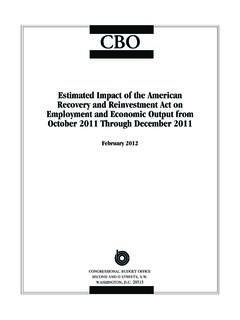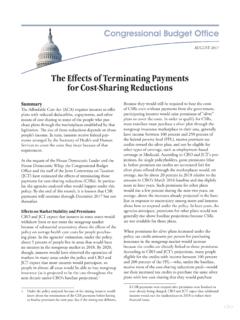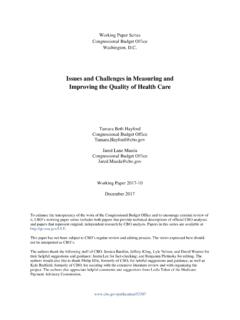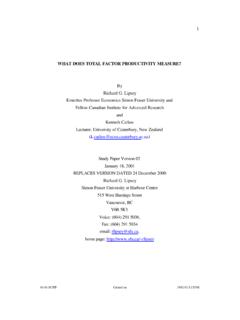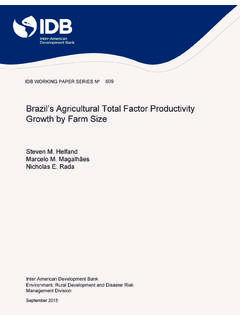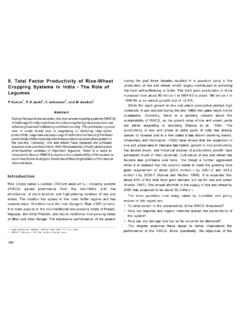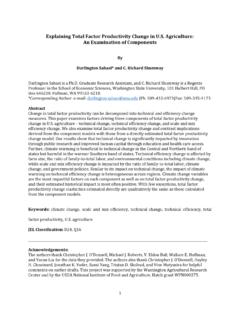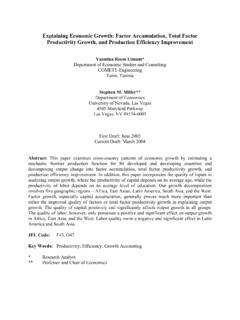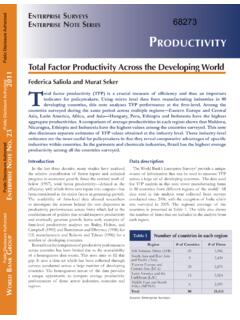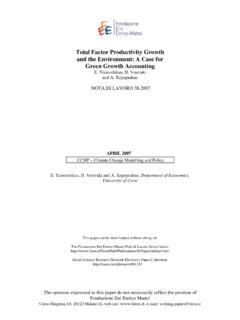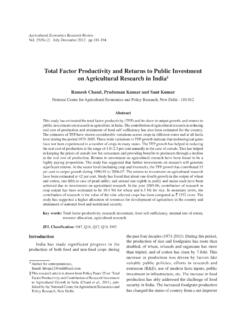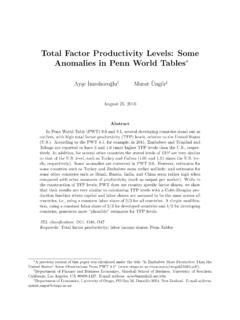Transcription of Total Factor Productivity Growth in Historical Perspective
1 Working Paper Series Congressional Budget Office Washington, Total Factor Productivity Growth in Historical Perspective Robert Shackleton Congressional Budget Office March 2013 Working Paper 2013 01 To enhance the transparency of the work of the Congressional Budget Office (CBO) and to encourage external review of that work, CBO s working paper series includes both papers that provide technical descriptions of official CBO analyses and papers that represent independent research by CBO analysts. Working papers are not subject to CBO s regular review and editing process.
2 Papers in this series are available at The views expressed in this paper are the author s and should not be interpreted as CBO s. This paper is preliminary and is circulated to stimulate discussion and critical comment. The author thanks Alexander Field of Santa Clara University; Wendy Edelberg, Joseph Kile, Kim Kowalewski, Robert Arnold, and Benjamin Page (all of CBO); and William Randolph (formerly of CBO) for comments and suggestions. Total Factor Productivity Growth in Historical Perspective Abstract This paper reviews the broad contours of Total Factor Productivity (TFP) Growth in the economy since 1870, highlighting the contribution of various technological innovations to the Growth of different sectors of the economy.
3 The paper also notes the correlation between TFP Growth and improvements in general health and well-being as reflected in changes in life expectancy. Finally, the paper discusses the potential for continued Growth in TFP in the future. Introduction Economists have long found that they can explain only a portion of economic Growth by the Growth of inputs to production, such as the number of hours worked or the amount of capital used. The unexplained (or residual) portion, which presumably reflects advances in production technologies and processes, is conventionally attributed to all of the production factors together and is referred to as Total Factor Productivity (TFP) Over the past century or more, gains in TFP have accounted for well over half the Growth in measured labor Productivity (output per hour of work)
4 That is, they have contributed more to the measured Growth of labor Productivity than has Growth in the amount of capital per worker and they are likely to be critical for future economic Growth as well. To provide a sense of the importance of TFP to long-term economic Growth , this paper summarizes current understanding of Historical TFP Growth in the United States. It describes how trends in both industry-specific TFP Growth and overall TFP Growth have varied over time, and discusses some of the important technological and institutional sources of TFP Growth .
5 It also touches on ways in which estimates of TFP Growth ignore other important innovations that have contributed to improvements in well-being during the same period. Finally, the paper discusses how TFP Growth might evolve over the 21st century. Researchers in Growth accounting vary in their approaches, in the data they use and the periods of time they analyze, and in the extent of economic activity they analyze and the factors they try 1 Some experts prefer the term multifactor Productivity (MFP) Growth on the argument that studies do not really measure all factors that may contribute to economic Growth , as implied by the concept of TFP.
6 2 to take into This paper focuses on estimates of TFP that draw on the National Income and Product Accounts (NIPAs) published by the Bureau of Economic Analysis and that measure the residual share of gross domestic product (GDP) as reported in the NIPAs. As a consequence, such estimates of TFP are only as comprehensive a measure of economic improvement as is GDP itself. Because the NIPAs focus overwhelmingly on the value of goods and services exchanged in markets, they (and the TFP measures developed from them) do not explicitly measure improvements in well-being for example, more leisure time, or improvements in health and life expectancy that result from technological innovations or from policies such as environmental regulations that are not measured in market transactions.
7 (However, medical advances, by improving labor Productivity and extending working lives, may indirectly contribute to Growth in measured GDP.) This paper focuses on a rather broad measure of TFP that includes factors that some other studies account for separately. For example, researchers who explicitly account for improvements in the quality of the labor force attributable to educational attainment find that, over the past half-century or so, those improvements have accounted for roughly one-third of the Growth that this paper attributes to TFP.
8 2 Most statistics presented here draw from research by Field (2012) or by Gordon (1992, 1996, 2000, 2010, and 2012) but draw from other studies as well. The Productivity statistics generally apply to the private nonfarm sector or the nonfarm business sector (which excludes housing). Statistics for life expectancy draw from Carter et al. (2006), vol. 1, pp. 440 441. 3 Sources of Growth Productivity Growth is often popularly associated with the invention of new products, tools, and technical processes that not only reduce the cost of extracting or producing raw materials and energy but also reduce the cost of transforming those inputs into finished products.
9 Moreover, quantities of inputs and outputs are easier to measure in manufacturing than in complex service industries, such as health care. Researchers therefore tend to concentrate on the production of goods and on manufacturing, in particular in seeking sources of Productivity Growth . Manufacturing has indeed tended to register significant Growth in TFP, and, in some periods the 1920s, in particular has accounted for the bulk of aggregate TFP Growth . Nevertheless, with the exception of a few years during World War II, manufacturing has never employed much more than a third of the labor force or produced more than a third of nominal output.
10 As discussed below, at various times rapid Productivity Growth has occurred in other sectors of the economy as well. Outside of manufacturing and a few other industries whose inputs and output are easily measured, such as electricity generation, serious data problems hinder the ability to estimate Historical (and even current) TFP Growth . Growth is particularly difficult to measure in many service sectors. The health sector is perhaps the most notable and important case: The data show little improvement in TFP in health care despite dramatic and continuous improvements in health and despite an average increase in life expectancy at birth of about two and a half years per decade over the past century and a half.

